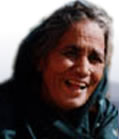 |
 |
||
 |
|||
|
RELATED THEMES development education employment and income livestock social change OTHER LOCAL THEMES BACKGROUND |
migration
Narrators refer to several forms of migration, some of which has been part of people's lives for generations, such as seasonal migration with livestock from the villages to higher summer pastures. Some Gujjar and Bhotiya narrators describe in detail their previous semi-nomadic existence, when they traded with Tibetans. The border is now closed and government pressure to settle means such long-distance migration is a thing of the past. But it is permanent migration away from the villages to more urban, often lowland areas in search of paid employment which most concerns people - and which is on the increase today. Many narrators say survival from farming alone is less and less feasible. As local jobs are scarce, family members (generally men) have to find work outside their communities to supplement the family income. "If the family is small they can fulfil their needs from the local resources. But a big family needs some side jobs. people need other jobs, employment, and it results in migration, the draining of manpower. Intellectuals and others will keep going to the plains unless and until there are more cottage industries established in this area because people having big families don't get adequate output from agriculture." (India 8) Some just go when times are quiet on the land; others stay on a permanent basis, sending money back to their families in the hills. As some narrators point out, the increasing trend to migrate reflects more than just economics. The desire for education, contact with the outside world, changed expectations - "the glitter of materialism" as one narrator calls it - all these factors exert influence. The effect on village life is significant. Many remark on the changes: "Only old men and womenfolk are staying back in the villages" (India 8). The loss is not just of labour; the tendency for the educated to leave constitutes a "brain drain": "Those who get educated go away from here. They have built houses in Delhi or Dehra Dun after leaving our Garhwal. Then how will the development of this place occur? Many don't like this place anymore, but those who have intelligence are coming up [from the plains] because they have money. And our people are running down [there] for money!" (India 6) The implications are complex and as the phenomenon increases, some warn it will bring cultural change: "the latest trend is that the entire family migrates. Therefore complete villages, in some cases, have no population at all. Thus our rural village culture is becoming extinct. At this rate very soon our mother tongue, the Garhwali language, will disappear. The children of the migrant families either do not know their language or do not like to speak it." (India 28) Work in the cities may seem better than mountain farming but one woman (India 1) is realistic about conditions: "I had been to Delhi. Our boys.live in houses that look like lavatories. They undergo so much hardship in their work and the landlord says all sorts of things to them. this is how they live in the towns. But we poor people are free, we have our own houses in our village and breath free air." She adds that they dress well when they come home, fuelling the illusion of the good life: ". when they return they wear good clothes. Over there they don't, I have seen that. How can they wear good clothes when they only wash dirty vessels the whole day? I have seen in the house of a military man, there are two servants.They remain bent over for [hours at a] time, they have to wash so many vessels. Perhaps people here think highly of them because they are in service." Many narrators present ideas to stem the depopulation. For most, investment in local business and agriculture in order to create jobs is absolutely critical. Some recognise that jobs alone are not enough. One says (India 7): "If the government provides resources for entertainment, tourism and communication, it would be helpful. Migration can be prevented and the economic condition can be changed. Students should also be given training for small-scale industries." The picture is not all gloomy: some say their children always return in the end ("Many people have come back to the village after retirement. They love their motherland" India 22); others remark that migrant workers bring back useful new ideas and approaches. India 30 says: ".people from Kumaon come back to their villages and cities on retirement. and guide the younger generation. That is why Kumaon has progressed." Whatever peoples' views of migration - and they are largely negative - most feel that it is the only way forward until local conditions improve: "The village is getting wealthier. now that the towns are providing opportunities for people. At home even if you break your heart nothing comes up in the villages. When we can't fill our stomachs from farming, they go to the towns to earn. Then they send money home through money orders. Then we are able to fulfil our needs with that money. That is how we exist." (India 4) quotes about migration"Many families have started migrating to the cities. They have purchased their own houses and farm lands because they need to settle there as they have their jobs in those cities. More earning means that better means of education and other facilities in the plains are sought after, because these are not available in the villages." "Some families do migrate sometimes for temporary jobs. Some women also accompany their husbands who are working in a distant place. They remain there because of the break they get from agricultural work. Some villagers also go out for a short period to places where they find more suitable conditions for... their cattle...when they feel scarcity of grass and fodder. They return after the hard season is over." "About going to work, certainly some people should go and work in a suitable way outside. Then it is a good thing. It is certainly not good that we should only remain sitting in our houses and see nothing at all." "[Migration's] bad impact is clearly seen and felt. Villages, one after another, are being deserted.Youths rush to the cities for jobs. This man power drain can only be stopped by establishment of cottage industries, creating job facilities here in the nearby area." |
|